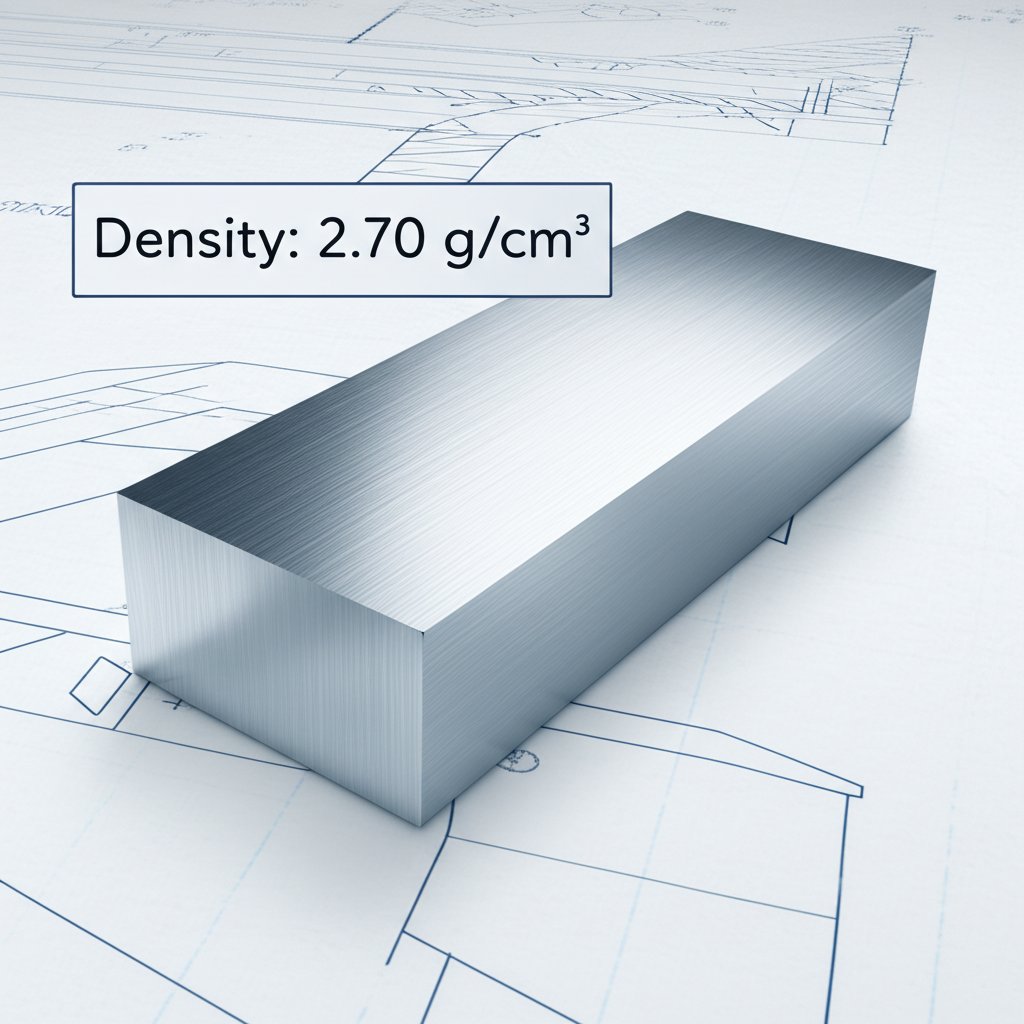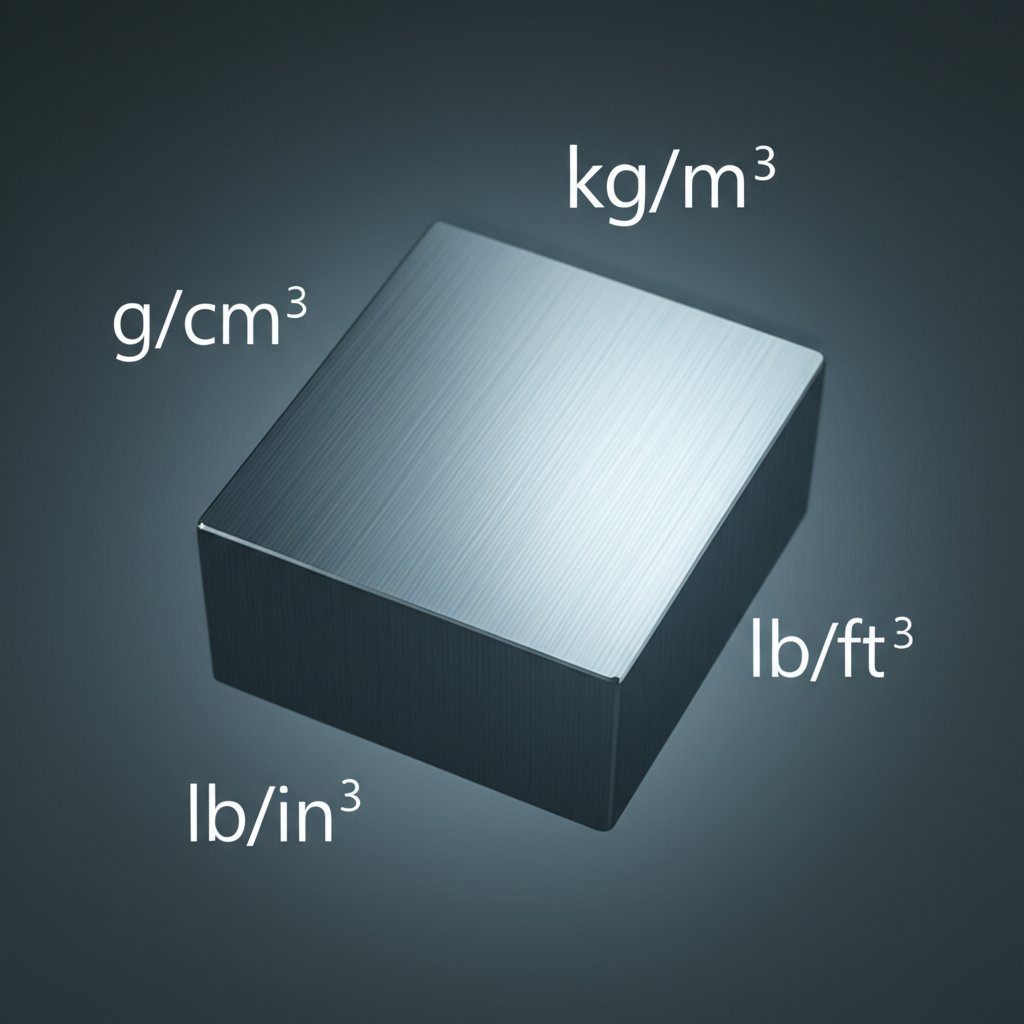
When you’re selecting materials for engineering or design, one of the first questions you might ask is: how heavy will this part be? That’s where the concept of density comes in. Put simply, density tells us how much mass is packed into a given volume of a material. This property is crucial for everything from lightweight aerospace components to robust structural frames.
Density is defined as the mass of a substance divided by its volume. The formula is: Density (ρ) = Mass (m) / Volume (V).
In the world of material science, knowing the density of aluminum or any other material helps engineers and fabricators predict the weight, strength, and performance of their designs. For example, if you know the mass density of aluminum, you can quickly estimate if a part will be light enough for an aircraft or strong enough for a bridge. It’s a foundational property that guides material selection, cost estimation, and safety calculations.
Now, imagine you’re working on a project that demands a material with excellent strength, corrosion resistance, and workability. That’s where aluminum 6061 comes into play. But what is 6061 aluminum? It’s one of the most versatile and widely used aluminum alloys, recognized for its balanced combination of properties. In fact, 6061 aluminum alloy is found in everything from bicycle frames and automotive parts to aerospace structures and consumer electronics.
Understanding what is aluminium density—especially for popular alloys like 6061—gives you a key data point for comparing materials and making informed design decisions. Since the density of aluminum is much lower than that of steel or copper, it’s often chosen to reduce weight without sacrificing too much strength. That’s why the specific density value for 6061 aluminum alloy is so important for professionals across industries.
In the next section, we’ll dive into the exact numbers you need to know about the density of 6061 aluminum—and why they matter for your next project.

When you’re designing a component or running calculations, having the precise density value for your material is essential. So, what is the density of 6061 aluminum? The answer is straightforward, but it’s important to present it in the units most commonly used by engineers and designers around the world.
The density of 6061 aluminum is typically cited as:
| Unit System | Unit | Value |
|---|---|---|
| Metric | g/cm³ | 2.70 |
| Metric | kg/m³ | 2,700 |
| Imperial | lb/in³ | 0.0975 |
| Imperial | lb/ft³ | 168.5 |
Let’s break that down:
Why are these numbers so important? Imagine you’re tasked with calculating the total aluminum density for a batch of extruded profiles, or you need to estimate shipping costs based on material weight. Having these values at your fingertips saves time and ensures accuracy in your engineering process.
It’s also worth noting that while the density of aluminum g/cm3 or density of aluminum kg/m3 might seem like a small detail, it’s actually a critical input for everything from structural analysis to cost estimation. Even a minor error in this value can lead to significant discrepancies in final part weight, especially in large-scale manufacturing or construction.
If you want to explore this topic further and see how 6061 compares to other alloys, check out this comprehensive guide: Aluminum Density: Your Essential Guide to Values & Alloys.
Next, we’ll address a common question: does heat treatment or tempering (like T6 or T4) actually change the density of 6061 aluminum? Let’s clear up the confusion.
When you’re researching aluminum alloys, it’s easy to get confused by the many “tempers” you’ll see—like T4, T6, or T651. But what is 6061 T6, and does changing the temper actually change the density of 6061 aluminum?
Let’s clear up a common misconception: Heat treatment (or tempering) has a dramatic effect on mechanical properties—such as strength and hardness—but it has almost no effect on the density of al 6061 T6 or any other 6061 tempers.
Sounds complex? Here’s why: The density of a material is determined by its atomic composition and how closely those atoms are packed. For 6061 aluminum, whether it’s in the T4 or T6 temper, the alloy’s basic chemical makeup remains the same. The heat treatments used to create these tempers only rearrange the microstructure (such as precipitate distribution or grain size) to boost certain properties. They don’t add or remove atoms, so the density of 6061 T6 aluminum is virtually identical to that of T4 or any other 6061 tempers.
To make this even clearer, let’s break it down. Imagine you’re comparing two bars of 6061 aluminum—one in T4 temper, the other in T6. If you weighed and measured both, you’d find the 6061 T6 density is the same as the T4. But if you performed a tensile test, you’d notice big differences in mechanical strength and ductility.
For example, according to authoritative data, both 6061-T4 and 6061-T6 aluminum have a density of approximately 2.70 g/cm³ (or 0.0975 lb/in³), regardless of temper. The real changes are in mechanical characteristics: 6061-T6 is artificially aged for maximum strength, while T4 is naturally aged and somewhat softer. In fact, the yield strength of T6 can be more than double that of T4, but the density of 6061 T6 remains unchanged.
So, why bother with different 6061 tempers like T6 or T4 if the density doesn’t change? The answer is all about application. If you need higher strength for a structural beam or critical aerospace part, 6061 T6 is often the go-to choice. If you need better formability or are planning to do extensive bending or welding, you might choose T4. But in either case, your calculations for part weight—based on 6061 aluminum density—will use the same value.
In summary, while the density of 6061 T6 (and all 6061 tempers) is consistent, the choice of temper dramatically affects how the material behaves under load. This distinction is crucial for engineers and designers who need to balance weight, strength, and manufacturability.
Next, we’ll see how the density of 6061 stacks up against other popular engineering metals, giving you a broader perspective for material selection.

When you’re making critical design decisions, it’s easy to ask: just how light is 6061 aluminum compared to other engineering metals? Imagine you’re weighing options for a bike frame, aircraft component, or structural support—knowing the density of each material can make or break your project’s performance, cost, and manufacturability.
Let’s put things in perspective with a direct comparison. The table below highlights the typical density values for 6061 aluminum, other common aluminum alloys, stainless steel, and titanium. This side-by-side view helps you quickly see why 6061 is a go-to for lightweight applications, and how it stacks up against alternatives when strength-to-weight ratio is a priority.
| Material | Alloy/Grade | Typical Density (g/cm³) |
|---|---|---|
| Aluminum | 6061 | 2.70 |
| Aluminum | 6063 | 2.70 |
| Aluminum | 7075 | 2.81 |
| Aluminum | 5052 | 2.68 |
| Stainless Steel | 304 | 8.00 |
| Titanium | Grade 5 (Ti-6Al-4V) | 4.50 |
Looking at the numbers, you’ll notice that 6061 aluminum’s density (2.70 g/cm³) is less than half that of titanium metal density (4.5 g/cm³) and dramatically lower than stainless steel density (8.0 g/cm³). That’s a game-changer for applications where every ounce counts. For example, switching from a steel to an aluminum alloy 6061 vs 6063 may not change the density, but it could impact the strength, corrosion resistance, or surface finish—key considerations for your design.
Let’s break down why this matters:
So, what’s the real-world takeaway? If you want a material that’s strong, easy to fabricate, and exceptionally lightweight, 6061 aluminum is hard to beat. Its density gives you a huge advantage for parts that need to be moved, lifted, or accelerated. But if you need extreme strength or corrosion resistance—and can handle the added weight or cost—materials like 7075 aluminum, stainless steel, or grade 5 titanium may be worth considering.
Ultimately, choosing between aluminum alloy 6061 vs 6063, or weighing the pros and cons of aluminum versus titanium, comes down to your project’s unique requirements. Do you need the lowest possible weight? Maximum strength? Best corrosion resistance? Or a balance of all three?
In the next section, we’ll show you how to use these density values to calculate the weight of your own parts—helping you make confident, data-driven decisions for your next engineering project.
Ever wondered how much a finished aluminum part will weigh before you even start production? Knowing how to calculate the weight of a component using the 6061 aluminum density is a must-have skill for engineers, fabricators, and buyers alike. Whether you’re estimating shipping costs, verifying structural loads, or just double-checking a supplier’s quote, this method puts you in control.
The calculation is surprisingly straightforward. All you need to know are two things:
The basic formula is:
Weight = Volume × Density
But how do you actually use this in practice? Let’s walk through a real-world example that you can easily adapt to your own needs.
Imagine you need to find the weight of a 1-meter long, 50mm x 50mm square bar made from 6061 aluminum. Here’s how you’d calculate it step by step:
So, your 1-meter 50mm × 50mm 6061 aluminum bar will weigh 6.75 kg.
If you prefer to work in imperial units, let’s try the same calculation for weight of aluminum per cubic inch. First, convert the bar’s dimensions to inches (1 meter = 39.37 inches; 50mm = 1.969 inches):
So, the weight of aluminium per cubic inch is 0.0975 lb, and for this bar, the total weight is approximately 14.88 lb.
By mastering this simple calculation, you’ll gain confidence in estimating the weight of any aluminum part—no matter how complex the design. This practical knowledge is crucial for optimizing material use, ensuring safety, and keeping costs in check as you move forward in your project.
Next, we’ll connect these weight calculations to the strength-to-weight ratio—a key metric in modern engineering that explains why 6061 aluminum is so popular in demanding applications.

When you’re designing for aerospace, automotive, or even high-performance sports equipment, you’ll quickly face a classic challenge: how do you maximize strength without adding unnecessary weight? That’s where the concept of the strength-to-weight ratio comes into play—and it’s one of the main reasons 6061 aluminum density is so often discussed by engineers and designers.
The strength-to-weight ratio is a critical factor in modern engineering—allowing designers to build lighter, more efficient structures without sacrificing safety or performance.
Imagine you’re building a drone frame or a racing bike. If you use a material that’s strong but heavy, your design might be robust, but it’ll be difficult to move or accelerate. On the other hand, a material that’s light but weak could fail under stress. That’s why 6061 aluminum is such a popular choice: it offers a unique balance of low density and impressive mechanical strength.
Let’s break down what makes this alloy stand out. With a density of just 2.70 g/cm³ (0.0975 lb/in³), 6061 aluminum is significantly lighter than steel or even titanium. But what about its ability to handle stress? Here’s where its mechanical properties shine:
The yield strength of aluminum refers to the maximum stress it can withstand before it begins to deform permanently. In the case of 6061-T6, the yield point aluminum is high enough for demanding structural applications, yet the alloy remains light and easy to machine. The tensile strength of aluminum tells you how much force the material can handle before it actually breaks—another key metric for safety-critical parts.
So, why does this combination matter? When you combine the 6061 aluminum yield strength with its low density, you get a material that’s ideal for:
This is why the yield stress of aluminum—especially in the T6 temper—is so frequently cited in engineering specs. For example, 6061 T6 aluminum yield strength provides a reliable benchmark for structural calculations, giving designers confidence that their parts will perform as expected under load.
In summary, the strength-to-weight ratio defines why 6061 aluminum is so versatile. Its combination of low density and robust mechanical properties means you can design lighter structures without sacrificing safety or durability—a win-win for modern engineering.
Next, let’s broaden our view and explore some of the other key properties that make 6061 aluminum a go-to material for so many industries.
When you’re evaluating materials for demanding engineering applications, density is just one part of the equation. Have you ever wondered how well a material resists bending or stretching under load? That’s where the modulus of elasticity of aluminum—also called Young’s Modulus—comes into play. This property measures stiffness: the higher the value, the less a material will deform when you apply force.
For 6061 aluminum properties, the modulus of elasticity is a standout feature. According to authoritative data, the Young's modulus of aluminum 6061 is approximately 68.9 GPa (10,000 ksi) (MatWeb). This means that 6061 aluminum offers a solid balance of flexibility and rigidity—stiff enough for structural frames, yet not so brittle that it snaps under stress.
Why does this matter in real-world terms? Imagine you’re designing a lightweight bridge truss or a high-performance bike frame. You want a material that will flex just enough to absorb shocks, but not so much that it loses shape or fails. The elastic modulus of aluminum ensures that 6061 is up to the task, making it a preferred choice for load-bearing yet weight-sensitive projects.
These values highlight the alloy’s ability to handle both tension and compression, providing predictable, linear behavior under normal service conditions. For engineers, this means you can confidently model and simulate 6061 aluminum’s response in everything from civil structures to precision equipment.
But what about heat? If your application involves rapid temperature changes or requires efficient heat dissipation, the thermal properties of 6061 aluminum are just as important as its mechanical ones. This alloy stands out for its excellent thermal conductivity, making it a go-to material for heat sinks, electronic housings, and automotive components.
What does this mean for you? If you’re designing parts that will see frequent heating and cooling, such as automotive engine components or LED housings, 6061 aluminum’s high thermal conductivity ensures rapid, even heat transfer. The alloy’s moderate coefficient of thermal expansion also minimizes the risk of warping or stress fractures during temperature swings.
These 6061 aluminum properties round out the alloy’s profile, showing why it’s so widely chosen for high-performance, multi-functional applications. The combination of a reliable aluminum modulus of elasticity, strong fatigue resistance, and efficient heat transfer makes 6061 aluminum a top pick for everything from aerospace structures to consumer electronics.
Now that you understand the full range of mechanical and thermal characteristics, you’re ready to make smarter choices for your next project. In the final section, we’ll discuss why sourcing quality 6061 aluminum from a reputable supplier ensures you consistently get these properties in every batch.
After learning about the mechanical, thermal, and density properties of 6061 aluminum, you might be wondering: how do you ensure the material you receive matches these expectations every time? The answer is simple but critical—partner with a supplier who understands the importance of consistency and quality in material 6061 aluminium.
Imagine investing in a complex structure or high-performance component, only to find the density or mechanical properties are inconsistent from batch to batch. This isn’t just a minor inconvenience—it can lead to compromised safety, unexpected failures, or costly rework. That’s why, whether you’re sourcing an al 6061 t6 plate for a precision aerospace part or need custom extrusions for architectural projects, choosing the right supplier is as important as selecting the right alloy.
When evaluating suppliers for a6061 material or al 6061 alloy, here are a few key factors to consider:
For example, Shengxin Aluminium stands out as a professional manufacturer specializing in high-grade aluminum profiles that meet stringent global standards. Whether you require bulk shipments or custom-engineered solutions, working with an experienced supplier ensures your 6061 aluminum’s density, strength, and finish are never left to chance. This is especially important for projects where consistency and reliability are non-negotiable—and where factors like aluminium 6061 price per kilogram must be balanced with quality and performance.
In summary, specifying the right material 6061 aluminium is only the first step. To truly unlock the benefits of this versatile alloy, make sure you’re sourcing it from a supplier who shares your commitment to quality, precision, and long-term value. That way, every part you produce—whether it’s a lightweight frame, a structural beam, or a custom extrusion—will deliver on the promise of 6061 aluminum’s unique properties.
6061 aluminum has a density of 2.70 g/cm³, 2,700 kg/m³, 0.0975 lb/in³, or 168.5 lb/ft³. These values are essential for accurate weight calculations in both metric and imperial systems.
No, the temper such as T6 or T4 does not significantly change the density of 6061 aluminum. While tempering alters mechanical properties like strength and hardness, the density remains consistent because the alloy's atomic structure is unchanged.
6061 aluminum is much lighter than stainless steel and titanium. For example, stainless steel 304 has a density around 8.00 g/cm³, titanium Grade 5 about 4.50 g/cm³, while 6061 aluminum is 2.70 g/cm³. This makes 6061 ideal for weight-sensitive applications.
To calculate weight, multiply the part's volume by the density of 6061 aluminum (e.g., 2.70 g/cm³ or 0.0975 lb/in³). Ensure your units match for accurate results. For example, a 1-meter 50mm x 50mm bar weighs about 6.75 kg.
Consistent density and mechanical properties are crucial for safety and performance. Trusted suppliers like Shengxin Aluminum provide certified, high-quality 6061 profiles, ensuring your material meets industry standards and project requirements.
 บริการออนไลน์
บริการออนไลน์ 0086 136 3563 2360
0086 136 3563 2360 sales@sxalu.com
sales@sxalu.com +86 136 3563 2360
+86 136 3563 2360